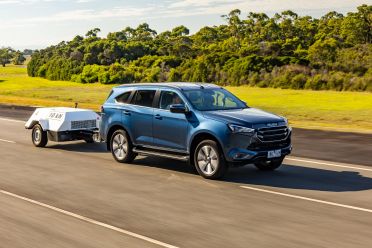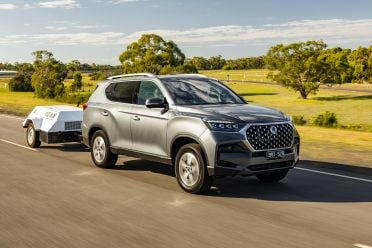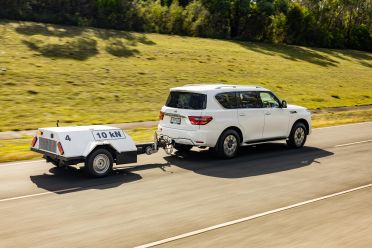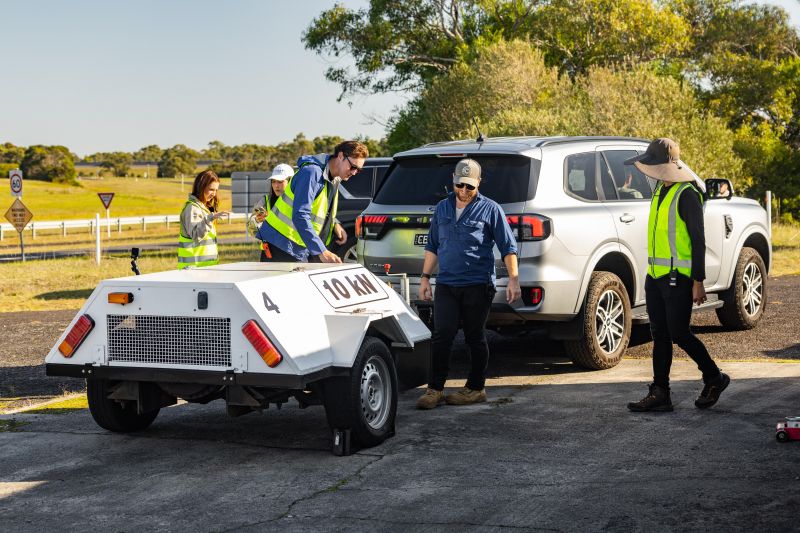Large, seven-seat four-wheel drives with low-range aren’t traditionally thought of as performance cars, but how well they accelerate and brake is critical.
After all, a few metres can be the difference between your family emerging unscathed from an emergency stop, and an expensive repair bill.
Along with a round-robin drag race, we subjected the vehicles on our test to a series of performance tests – both unladen, and with our 3kN dyne trailer attached.
On the back of those tests, we’ve awarded the best-performing 4WD SUV overall, and the best-performing four-cylinder model. Those awards are based on all the tests conducted – and are revealed at the end of this story.
To stay across everything that’s happening with the 4WD SUV Mega Test, check out our dedicated page. Our next video to go live will be the towing test on Monday, June 12.
Unladen performance testing
We used the high-speed bowl at the VinFast (nee Holden) Proving Ground in Lang Lang, Victoria, for our testing.
We measured their 0-100km/h sprint time, and their 100km/h-0 braking distance. Overtaking ability was tested, as was the standing quarter mile.
The results are laid out in a series of tables below:
| Vehicle | 0-100km/h | 100-0km/h | 1/4 mile |
|---|---|---|---|
| Ford Everest Platinum V6 | 9.39s | 3.16s @ 44.74m | 16.80s @ 135.44km/h |
| Ford Everest Trend Bi-Turbo | 10.78s | 3.4s @ 46.07m | 17.65s @ 125.84km/h |
| Isuzu MU-X | 11.27s | 3.04s @ 42.63m | 17.63s @ 124.14km/h |
| Nissan Patrol | 7.49s | 3.19s @ 44.99m | 15.43s @145.64km/h |
| Jeep Grand Cherokee L | 10.19s | 2.99s @ 40.19m | 17.25s @ 131.72km/h |
| Land Rover Defender 110 D300 | 8.10s | 3.21s @ 42.39m | 15.91s @ 141.35km/h |
| Land Rover Defender 110 P525 V8 | 5.43s | 2.96s @ 40.92m | 13.63s @ 169.02km/h |
| Lexus LX600 | 7.09s | 2.95s @ 41.76m | 15.05s @ 152.22km/h |
| Mitsubishi Pajero Sport | 12.61s | 3.54s @ 45.81m | 18.63s @ 120.01km/h |
| SsangYong Rexton | 11.09s | 3.30s @ 41.56m | 17.78s @ 126.18km/h |
| Toyota Fortuner | 10.97s | 3.38s @ 43.9m | 17.66s @ 129.76km/h |
| Toyota LandCruiser 300 | 8.11s | 3.35s @ 42.84m | 15.85s @ 143.20km/h |
| Toyota LandCruiser Prado | 11.38s | 2.93s @ 39.03m | 17.89s @ 126.03km/h |
| Vehicle | 60-100km/h | 80-120km/h |
|---|---|---|
| Ford Everest Platinum V6 | 5.26s | 7.04s |
| Ford Everest Trend Bi-Turbo | 6.16s | 8.40s |
| Isuzu MU-X | 7.00s | 9.03s |
| Nissan Patrol | 4.11s | 5.18s |
| Jeep Grand Cherokee L | 5.66s | 7.18s |
| Land Rover Defender 110 D300 | 4.48s | 5.87s |
| Land Rover Defender 110 P525 V8 | 2.76s | 3.40s |
| Lexus LX600 | 3.71s | 4.57s |
| Mitsubishi Pajero Sport | 7.26s | 10.17s |
| SsangYong Rexton | 6.30s | 8.55s |
| Toyota Fortuner | 6.19s | 7.57s |
| Toyota LandCruiser 300 | 4.43s | 5.53s |
| Toyota LandCruiser Prado | 6.61s | 8.28s |
Laden tests
We got our hands on a state-of-the-art trailer dynamometer with a variable load retarder that allowed us to impart up to 10kN of resistive load to the tow vehicle.
What does this mean in real terms? Think of the trailer dynamometer as an anchor. Varying the dynamometer load allows us to change the weight of that anchor.
This weighted anchor allows us to simulate a long steep climb for the tow vehicle, which ultimately puts immense load on the engine.
This 1600kg trailer dynamometer is wirelessly linked up to a computer that lets the operator adjust the degree of resistance force as measured in kilonewtons (kN) – in our tests we set it to 3kN, which simulates a fairly steep ascent, but one that should be within each vehicle’s abilities.
With this trailer attached we measured the 0-100km/h time, as well as the 0-90km/h time, because as you’ll see not all of the competitors made it to three digits.
| Vehicle | 0-90km/h | 0-100km/h | 60-100km/h |
|---|---|---|---|
| Ford Everest Platinum V6 | 13.30s | 17.18s | 10.54s |
| Ford Everest Trend Bi-Turbo | 16.01s | FAIL | FAIL |
| Isuzu MU-X | 19.05s | FAIL | FAIL |
| Nissan Patrol | 10.08s | 12.47s | 7.11s |
| Jeep Grand Cherokee L | 15.40s | FAIL | FAIL |
| Land Rover Defender 110 D300 | 10.31s | 12.66s | 7.32s |
| Lexus LX600 | 9.62s | 11.36s | 7.01s |
| Mitsubishi Pajero Sport | 23.24s | FAIL | FAIL |
| SsangYong Rexton | 18.79s | FAIL | FAIL |
| Toyota Fortuner | 17.58s | FAIL | FAIL |
| Toyota LandCruiser 300 | 11.65s | 14.13s | 7.83s |
| Toyota LandCruiser Prado | 18.58s | FAIL | FAIL |
Then we did another two fuel economy laps to see how hard the engine was working with the load active. Fuel economy is a key consideration for anyone who’s towing a big, heavy trailer a long way.
Here’s how each car’s indicated fuel economy changed with the dyne trailer attached on the high-speed bowl.
| Vehicle | Fuel economy | Laden fuel economy |
|---|---|---|
| Ford Everest Platinum V6 | 9.0L/100km | 32.2L/100km |
| Ford Everest Trend Bi-Turbo | 7.6L/100km | 28.4L/100km |
| Isuzu MU-X | 8.2L/100km | 27.4L/100km |
| Nissan Patrol | 10.9L/100km | 35.7L/100km |
| Jeep Grand Cherokee L | 8.4L/100km | 39.8L/100km |
| Land Rover Defender 110 D300 | 7.2L/100km | 29.2L/100km |
| Lexus LX600 | 9.6L/100km | 37.2L/100km |
| Mitsubishi Pajero Sport | 9.2L/100km | 32.3L/100km |
| SsangYong Rexton* | 8.1L/100km | 25.0L/100km* |
| Toyota Fortuner | 9.2L/100km | 28.9L/100km |
| Toyota LandCruiser 300 | 9.0L/100km | 31.4L/100km |
| Toyota LandCruiser Prado | 8.4L/100km | 30.4L/100km |
As explained in our towing test, the SsangYong Rexton’s cruise control wouldn’t hold the vehicle at 100km/h and kept slowing down to around 70km/h before changing down a gear. As a result, this laden fuel economy result is worth discounting.
But wait, there’s more data!
Along with the data above, we recorded a few extra figures that may be useful to potential owners.
Using our GPS performance logger, we tracked how fast each SUV was actually going at an indicated 100km/h.
| Vehicle | GPS speed at indicated 100km/h |
|---|---|
| Ford Everest Platinum V6 | 97km/h |
| Ford Everest Trend Bi-Turbo | 96km/h |
| Isuzu MU-X | 95km/h |
| Nissan Patrol | 92km/h |
| Jeep Grand Cherokee L | 96km/h |
| Land Rover Defender 110 D300 | 96km/h |
| Lexus LX600 | 97km/h |
| Mitsubishi Pajero Sport | 95km/h |
| SsangYong Rexton | 93km/h |
| Toyota Fortuner | 98km/h |
| Toyota LandCruiser 300 | 97km/h |
| Toyota LandCruiser Prado | 97km/h |
Finally, we used our calibrated sound meter to measure how loud each car was at 80km/h and 100km/h on smooth and coarse road surfaces.
| Vehicle | Smooth 80km/h | Smooth 100km/h | Coarse 80km/h | Coarse 100km/h |
|---|---|---|---|---|
| Ford Everest Platinum V6 | 57.8dB | 62.5dB | 63.3dB | 67.0dB |
| Ford Everest Trend Bi-Turbo | 60.6dB | 62.5dB | 62.6dB | 65.6dB |
| Isuzu MU-X | 62.2dB | 65.8dB | 66.0dB | 68.1dB |
| Nissan Patrol | 58.4dB | 62.1dB | 63.6dB | 66.3dB |
| Jeep Grand Cherokee L | 60.3dB | 62.9dB | 67.8dB | 69.0dB |
| Land Rover Defender 110 D300 | 59.2dB | 63.0dB | 66.1dB | 67.8dB |
| Lexus LX600 | 57.7dB | 61.2dB | 62.1dB | 65.0dB |
| Mitsubishi Pajero Sport | 61.2dB | 63.5dB | 65.7dB | 68.5dB |
| SsangYong Rexton | 58.3dB | 61.9dB | 63.9dB | 66.2dB |
| Toyota Fortuner | 62.7dB | 66.3dB | 66.2dB | 70.0dB |
| Toyota LandCruiser 300 | 60.3dB | 62.7dB | 64.4dB | 66.2dB |
| Toyota LandCruiser Prado | 58.5dB | 64.1dB | 64.2dB | 67.2dB |
And the winners are…
The best performance 4WD SUV is the Lexus LX600.
Not only is it quicker in a straight line than all its rivals barring the slightly unhinged Defender 110 V8, was the quietest on every road surface at every speed, and didn’t lose its breath with our 3kN trailer attached.
Throw in an impressive performance in the braking test, and there was no real doubt as to our winner.
The best-performing four-cylinder is the Ford Everest Bi-Turbo.
It’s lived sightly in the shadow of its V6 sibling since launch, but the difference between the pair was impressively narrow in our testing – and the Everest was a more capable, comfortable performer than the MU-X, Fortuner, Prado, Rexton, and Pajero Sport in the majority of our unladen tests.
Throw a trailer on the back and it really shines, as the data collected with our 10kN trailer hooked up shows.
The impact of its all-terrain tyres shows in the braking test, however. There’s still room for improvement, even if the Everest represents the summit of four-cylinder performance in our testing.
To stay across everything that’s happening with the 4WD SUV Mega Test, check out our dedicated page. Our next video to go live will be the towing test on Monday, June 12.







